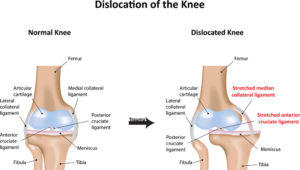Multi-Ligament Knee Injury Specialist

Are you an athlete who participates in contact sports? If so, you may be at risk of sustaining a complex knee injury. Severe high-energy injuries can result in a knee dislocation which can tear multiple ligaments in the knee. Complex knee injury specialist, Dr. Jeff Padalecki provides diagnosis and both surgical and nonsurgical treatment options for patients in Austin who have developed a complex knee injury. Contact Dr. Padalecki’s team today!
An Overview of Multi-Ligament Knee Injuries
The knee is comprised of four major ligaments that maintain the knee’s stability for walking, pivoting, and virtually any athletic activity. These ligaments work together to prevent excessive, unnatural motion between the femur (thigh bone) and tibia (leg bone). Each ligament in the knee serves a distinct purpose and any one of them can become injured at anytime if trauma occurs to the knee.
The four ligaments of the knee are:
- Anterior cruciate ligament (ACL) – located in the middle of the knee
- Posterior cruciate ligament (PCL) — located just behind the ACL
- Medial collateral ligament (MCL) — located on the inside of the knee and extends from the end of the thigh bone (femur) to the top of the shin bone (tibia)
- Lateral collateral ligament (or fibular collateral ligament) — located on the outside of the knee, connecting the thigh bone (femur) to the top of the calf bone (fibula)
While the majority of knee ligament injuries typically only involve a single ligament, there are certain occurrences that can cause multiple ligaments to be damaged at the same time. Multi-ligament knee injuries could occur as a result of a direct hit to the knee in a sporting activity, a fall from a height or from an impact during a motor vehicle collision. In many of these cases, the knee can become dislocated which has the potential to disrupt the nerves and arteries of the leg. Because of the severity of an injury of this magnitude, a multi-ligament injury requires immediate emergency care and in most situations, surgery. Dr. Jeff Padalecki, orthopedic knee specialist serving patients in Austin, Round Rock, and Cedar Park, Texas communities, is highly trained and experienced at treating this complex knee injury.
What are the Symptoms of Multi-Ligament Knee Injuries?
Pain and swelling are common symptoms in a knee dislocation. The knee may feel unstable or like it might “give way” and patients may not be able to put any weight on the knee. Walking will almost be impossible. Patients may describe a “popping” sound at the time of the injury. Signs of vascular insufficiency may be present in severe injuries that include blood vessel disruption.
How are Multi-Ligament Knee Injuries Diagnosed?
In many cases when a multi-ligament knee injury occurs, patients may seek immediate care through the nearest ER; if a dislocation has occurred with this complex injury, the attending orthopedic doctor in the emergency room may perform a prompt reduction of the knee, placing gentle traction on the leg to put the knee back into place. Once Dr. Padalecki is able to examine the full extent of the injury, he will likely perform an MRI. The MRI will allow him to look at all of the structures in and around the knee and determine if multiple ligaments are affected.
How are Multi-Ligament Knee Injuries Treated?
In the vast majority of multi-ligament injuries, immediate surgery is necessary to repair the damage and prevent further nerve or vascular damage. Early treatment allows for improved function during the healing process, a better possibility for the return to an active lifestyle, and a decrease in the progression of arthritis in the future. A very involved surgical reconstruction is performed utilizing grafts to restore the anatomy of the knee. Dr. Padalecki will almost always try and perform a multi-ligament repair in one single surgery since the ligaments of the knee all respond and rely on each other for stability.
What Occurs After Complex Knee Ligament Surgery?
Patients will be required to wear a brace for a prolonged period of time. After surgery, the patient is usually on crutches for approximately 6-8 weeks and will start a slow and methodical rehabilitation program focusing on returning the knee to a normal range of motion and strength. Surgery for multi-ligament knee repair will have a less than optimal outcome if a thorough rehabilitation program is not followed concurrently. After that is achieved, you will follow a progressive strengthening program to protect the reconstructed knee over a course of a few months.
For additional information on the treatment methods used to correct and repair multi-ligament knee injuries, please contact the office of Dr. Jeffrey Padalecki, orthopedic knee specialist in Austin, Texas.
